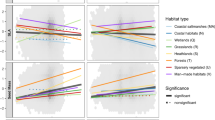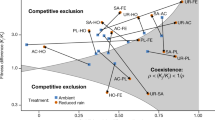Abstract
It has been hypothesised that climate change may affect vegetation by changing the outcome of competitive interactions. We use a space-for-time approach to evaluate this hypothesis in the context of alpine time-of-snowmelt gradients. Principal response curves, a multivariate repeated-measurement analysis technique, are used to analyse for compositional differences in local ridge-to-snowbed gradients among 100 m altitudinal bands from 1,140 to 1,550 m a.s.l., corresponding to a temperature gradient of 2.5°C (local lapse rate is 0.6°C). The interaction between time-of-snowmelt and altitude is strongly significant statistically, indicating that the altitudinal gradient cannot be explained simply by the physiological responses of the species, but that there are also changes in the outcome of competitive interactions. At higher altitudes, there is a decrease in the time-of-snowmelt ranges of species which have intermediate times-of-snowmelt optima, whereas snowbed (chinophilous) species have wider time-of-snowmelt ranges. As snowbed species can survive, grow and reproduce at very early snow-free sites at high altitudes, the most likely explanation for their absence from all but the latest time-of-snowmelt habitats at lower altitudes is competitive exclusion by more vigorous lee-side species. This suggests that with future climate change snowbed species will experience, in addition to habitat fragmentation and reduced size of habitats due to increased temperature and snowmelt, an indirect effect due to competitive exclusion from late-snowmelt sites by species that have their optima outside snowbeds.



Similar content being viewed by others
References
Arft AM and 28 other authors (1999) Responses of tundra plants to experimental warming: meta-analysis of the International Tundra Experiment. Ecol Monogr 69:491–511
Aune E (1993) Temperatur normaler normalperiode 1961–1990. Det Norske Meteorologiske Institutt. Universitetsforlaget, Oslo
Billings WD, Bliss LC (1959) An alpine snowbank environment and its effects on vegetation, plant development, and productivity. Ecology 40:388–397
Braak CJF ter (1994) Canonical community ordination. Part I: basic theory and linear methods. Ecoscience 1:127–140
Braak CJF ter, Šmilauer P (2002) CANOCO reference manual and user’s guide. User’s guide: software for canonical community ordination (v. 4.5). Microcomputer Power, Ithaca, N.Y.
Brink PJ van den, ter Braak CJF (1997) Ordination of responses to toxic stress in experimental ecosystems. Tox Ecot News 4:173–176
Brink PJ van den, ter Braak CJF (1999) Principle Response Curves: analysis of time-dependent multivariate responses of a biological community to stress. Environ Toxicol Chem 18:138–148
Brink PJ van den, Hattink J, Bransen F, Van Donk E, Brock TCM (2000) Impact of the fungicide carbendazim in freshwater microcosms. II. Zooplankton, primary producers and final conclusions. Aquat Toxicol 48:251–264
Brink PJ van den, van den Brink NW, ter Braak CJF (2003) Multivariate analysis of ecotoxicological data using ordination: demonstrations of utility on the basis of various examples. Aust J Ecotoxicol 9:141–156
Chapin FS III, Jefferies RL, Reynolds JF, Shaver GR, Svoboda J (1992) Arctic plant physiological ecology: a challenge for the future. In: Chapin FS III, Jefferies RL, Reynolds JF, Shaver GR, Svoboda J (eds) Arctic ecosystems in a changing climate: an ecophysiological perspective. Academic Press, San Diego, Calif.
Choler P, Michalet R, Callaway RM (2001) Facilitation and competition on gradients in alpine plant communities. Ecology 82:3295–3308
Dungan JL, Perry JN, Dale MRT, Legendre P, Citron-Pousty S, Fortin M-J, Jakomulska A, Miriti M, Rosenberg MS (2002) A balanced view of scale in spatial statistical analysis. Ecography 25:626–640
Førland EJ (1993) Nedbørnormaler normalperiode 1961–1990. Det Norske Meteorologiske Institutt. Universitetsforlaget, Oslo
Fortin M, Jacquez GM (2000) Randomization tests and spatially autocorrelated data. Bull Ecol Soc Am 81:201–205
Fortin M, Drapeau P, Legendre P (1989) Spatial autocorrelation and sampling design in plant ecology. Vegetatio 83:209–222
Frampton GK, van den Brink PJ, Gould PJL (2000) Effects of spring drought and irrigation on farmland arthropods in southern Britain. J Appl Ecol 37:865–883
Frisvoll AA, Elvebakk A, Flatberg KI, Økland RH (1995) Sjekkliste over norske mosar. NINA Temahefte 4:1–101
Gjærevoll O (1956) The plant communities of the Scandinavian alpine snow-beds. Det KGL Norske Videnskabers Selskabs Skrifter 1:1–405
Gottfried M, Pauli H, Grabherr G (1998) Prediction of vegetation patterns at the limits of plant life: a new view of the alpine-nival ecotone. Arct Antarct Alp Res 30:207–221
Gottfried M, Pauli H, Reiter K, Grabherr G (1999) A fine-scaled predictive model for changes in species distribution patterns of high mountain plants induced by climate warming. Divers Distrib 5:241–251
Gottfried M, Pauli H, Reiter K, Grabherr G (2002) Potential effects of climate change on alpine and nival plants in the Alps. In: Körner C, Spehn E (eds) Mountain biodiversity—a global assessment. Parthenon, Boca Raton
Grabherr G, Gottfried M, Gruber A, Pauli H (1995) Patterns and current changes in alpine plant diversity. In: Chapin FS III, Körner C (eds) Arctic and alpine biodiversity: patterns, causes and ecosystem and consequences. Springer, Berlin Heidelberg New York
Hall DK (1988) Assessment of polar climate change using satellite technology. Rev Geophys 26:26–39
Hartgers EM, Aalderink GHR, van den Brink PJ, Gylstra R, Wiegman JWF, Brock TCM (1998) Ecotoxicological threshold levels of a mixture of herbicides (atrazine, diuron and metolachlor) in freshwater microcosms. Aquat Ecol 32:135–152
Heegaard E (2002) A model of alpine species distribution in relation to snowmelt time and altitude. J Veg Sci 13:493–504
Houghton JT, Merio Filho LG, Callander BA, Harris N, Kattenburg A, Maskell K (eds) (2001) Climate change 1995—the science of climate change. Working group I, Second Assessment Report of the Intergovernmental Panel on Climate Change. Cambrige University Press, New York
Karivera PM, Kingsolver JG, Huey RB (1993) Biotic interactions and global change. Sinauer, Sunderland, Mass.
Körner C (1999) Alpine plant life. Springer, Berlin Heidelberg New York
Krog H, Østhagen H, Tønsberg T (1994) Lavflora: norske buske- og bladlav. Universitetsforlaget, Oslo
Legendre P (1993) Spatial autocorrelation: trouble or new paradigm? Ecology 74:1659–1673
Legendre P, Legendre L (1998) Numerical ecology, 2nd edn. Elsevier, Amsterdam
Leonard AW, Hyne RV, Lim RP, Pablo F, van den Brink PJ (2000) Riverine endosulfan concentrations in the Namoi river, Australia: link to cotton field runoff and macroinvertebrate population densities. Environ Toxicol Chem 19:1540–1551
Lid J, Lid DT (1994) Norsk flora, 6th edn. Det Norske Samlaget, Oslo
Matthews JA (1992) The ecology of recently-deglaciated terrain. Cambridge University Press, Cambridge
Maxwell B (1992) Arctic climate: potential for change under global warming. In: Chapin FS III, Jefferies R, Reynolds J, Shaver GR, Svoboda J (eds) Arctic ecosystem in a changing climate: an ecophysiological perspective. Academic Press, San Diego, Calif.
Méot A, Legendre P, Borcard D (1998) Partialling out spatial component of ecological variation: questions and propositions in the linear modelling framework. Environ Ecol Stat 5:1–27
Mooney HA (1991) Biological responses to climate change: an agenda for research. Ecol Appl 1:112–117
Onipchenko VG, Blinnikov MS, Aksenova AA (2001) Experimental evaluation of shading effects in seasonal dynamics of four alpine communities in Northwestern Caucasus, Russia. Arct Antarct Alp Res 33:330–339
Pauli H, Gottfried M, Grabherr G (1999) Vascular plants distribution patterns at the low-temperature limits of plant life—the alpine-nival ecotone of Mount Schrankogel (Tyrol, Austria). Phytocoenologia 29:297–325
Pearson RG, Dawson TP (2003) Predicting the impacts of climate change on the distribution of species: are bioclimate envelope models useful? Global Ecol Biogeogr 12:361–371
Perry JN, Liebhold AM, Rosenberg MS, Dungan J, Miriti M, Jakomulska A, Citron-Pousty S (2002) Illutrations and guidelines for selecting statistical methods for quantifying spatial pattern in ecological data. Ecography 25:578–600
Roots EF (1989) Climate change: high-latitude regions. Clim Change 15:223–253
Sandvik SM, Totland Ø (2000) Short-term effects of simulated environmental changes on phenology, reproduction, and growth in the late-flowering snowbed herb Saxifraga stellaris L. Ecoscience 7:201–213
Sandvik SM, Heegaard E, Elven R, Vandvik V (2004) Responses to long-term experimental warming in an alpine snow bed vegetation at Finse, south-western Norway. Ecoscience (in press)
Totland Ø, Nyhlén J (1998) Assessment of environmental change effects on performance and density of Bistorta vivipara by multivariate analysis and experimental manipulations. J Ecol 86:989–998
Vandvik V (2004) Gap dynamics in perennial subalpine grasslands: trends and processes change during secondary succession. J Ecol 92:86–96
Acknowledgements
We thank John Birks, Petr Šmilauer, Michael Gottfried, Christian Körner, and two anonymous reviewers for comments on earlier versions of the manuscript. We thank the Norwegian Research Council for financial support (140874/720 and 151637/432). This is publication no. A46 of the Bjerknes Centre for Climate Research.
Author information
Authors and Affiliations
Corresponding author
Rights and permissions
About this article
Cite this article
Heegaard, E., Vandvik, V. Climate change affects the outcome of competitive interactions—an application of principal response curves. Oecologia 139, 459–466 (2004). https://doi.org/10.1007/s00442-004-1523-5
Received:
Accepted:
Published:
Issue Date:
DOI: https://doi.org/10.1007/s00442-004-1523-5




